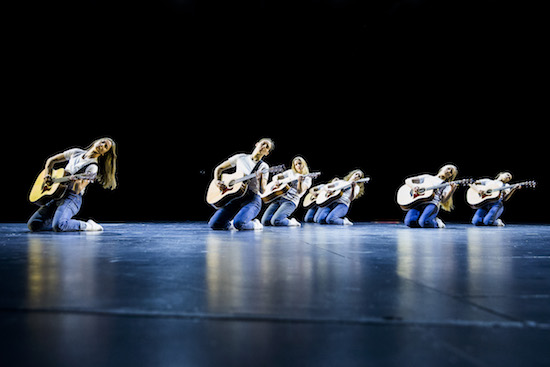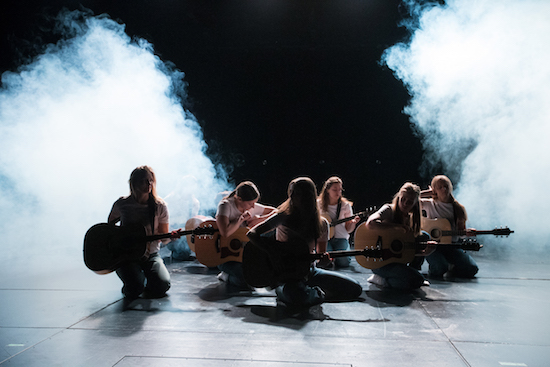Next weekend, the Royal Festival Hall will stage a spectacular multimedia performance by the Iceland Dance Company. Bringing together choreography, fine art, and film, Sacrifice promises to be a “festival of common things made holy, inspired by ideas around ritual, religion, and art.”
The show sees the Reykjavik-based troupe collaborating with international artists including Matthew Barney, Bryce Dessner, Valdimar Jóhannsson, Gabriela Friðriksdóttir, Ragnar Kjartansson, and Margrét Bjarnadóttir to produce a triptych of works that stretch the possibilities of the dance stage – and spill beyond it into the building’s foyers.
Craft/Work caught up with Kjartansson and Bjarnadóttir to discuss their contribution to the event, the evening’s middle segment, entitled ‘No Tomorrow’.
“It started with this idea: imagining a ballerina walking across the stage with an unamplified guitar, playing ‘Wild Horses’,” Kjartansson explains of the genesis of their piece. “Shit!” he exclaims suddenly, “That would work! Then I called Magga.”
A few years earlier, in September 2009, Bjarnadóttir had worked with Saga Sigurðardóttir on a work called ‘Pretty Bassic’, a “twenty minute choreographed concert for two bass guitars.” Aside from her extensive credentials as an artist and a choreographer, the fact that she had worked before with guitars on stage in a dance piece made her an obvious choice for that phonecall. “But that was an electric bass,” Bjarnadóttir points out. “So the sound didn’t travel.”
Kjartansson, by contrast, was interested in “this Stockhausen thing to do spatial music.” He was intent on “using the guitar to create a spatial sound with a dancer.”
“It was a different approach,” Bjarnadóttir says. “So this really excited me – that it was an acoustic guitar on a big stage, where sometimes the sound is very low, if they turned their back to the audience and then turned round. At times,” she says, “the sound is so fragile that it becomes embarrassing.”
“Never underestimate the power of the pathetic,” Kjartansson chips in gnomically.

No Tomorrow – Pictures by Jónatan Grétarsson. From performance in The Reykjavík City Theatre
Strummed in the bathtub at the Barbican, now plucked onstage by ballet dancers, the acoustic guitar has been playing an evermore prominent part in Kjartansson’s work of late. “An acoustic guitar is a very emotional instrument,” Kjartansson tells me. “Also, it’s the perfect instrument to work with spatial music on because it’s movable. There’s something about the guitar that is so direct.”
“It’s light but it’s big,” Bjarnadóttir adds. “It’s like you’re carrying another body.”
Chatting with Bjarnadóttir and Kjartansson is a heartwarming experience. When I first called up on the telephone, Bjarnadóttir had just arrived at Kjartansson’s apartment and the latter was still brushing his teeth. I felt strangely gratified that he insisted on fresh breath before conducting a conversation – even when his interlocutor was nearly 2,000 kilometres away. Throughout the conversation, all three of us were laughing and joking almost constantly, like old friends.
Little wonder, perhaps. The pair have worked together in the past – notably at TBA21 in Vienna in 2014. But their relationship stretches back much further than that. “We first met on a bus,” Bjarnadóttir explains. “When I was taking my bus to high school and he was taking his bus to art school. I would remember him there, and he was always so friendly and happy.”
“So then,” Kjartansson picks up, “when this idea came from the head of the dance company to do these individual pieces, right away I was just like, I will call Margrét!”
The pair set down to work on this latest piece in the shadow of momentous world events and in some sense, they agree, the finished piece couldn’t help but reflect that geopolitical backdrop – no matter how obliquely. “We started to work on it in January during the inauguration of Trump,” Bjarnadóttir says, “and it’s all we talked about, every lunch time, every coffee break.”
Do you think the work ended up absorbing some of the atmosphere from events in the news somehow? I ask.
“Totally,” Kjartansson replies. “Because it’s so much about nothing. It’s so nihilistic.”
“I just remember I needed to escape,” Bjarnadóttir says. “I wanted to live on another planet. And this was such a great escape. But at the same time, it’s not closing your eyes to it, but wanting to amplify something else. To show that there is still beauty.”
“It’s just about beauty,” Kjartansson says of the results. “One would think that the reaction would be total punk rock – but no it’s ballet!”
“Everything that the dancers need to perform this piece is everything that Trump does not have,” Bjarnadóttir says. “It’s all about grace and listening and inner strength. It’s not selfish. It’s the least selfish thing because they are all together and they really have to work as a whole. And there’s tenderness and a lot of sensitivity, because it’s crazy challenging, this piece, for the dancers because they are moving constantly while they are playing the guitar and so the coordination that they need to have is so huge.”
The piece proved a particular challenge for the dancers, most of whom had never played the guitar before, so they were learning the instrument during rehearsals whilst learning the dance steps at the same time. Things were made even more challenging by the complex rhythms provided by composer Bryce Dessner (from The National).
Once Dessner got involved, Kjartansson says, the show “really got wings”. Unbeknownst to either Kjartansson or Bjarnadóttir, the composer-guitarist has a long history of involvement with the dance. “His sister is a dancer,” Kjartansson explains. “And he’d been making music for her dance pieces since she was a teenager.” As a result, Dessner “knew how super clever dancers are. We would say, isn’t this music a little complicated? And he would say, oh no – they are dancers! They are the best counters in the world!”
Having full confidence in the intuitive rhythmic ability of the dancers, Dessner would write music for them “that you could not write for musicians” – despite the fact most of them had never even picked up a guitar before.
Dessner was perfect for the job, Kjartansson insists, because "he comes from both worlds – he comes from the contemporary music world and then he comes from the rock star world. So he knows the guitar from both sides. He can play with this emotional element of the guitar, which I think comes from the rock world, the ‘Wild Horses’ element."
"Collaboration," he concludes, "is so often about how one gets to know people and the pieces become excuses to collaborate."
Ragnar Kjartansson and Margret Bjarnadóttir’s new work No Tomorrow is part of the UK premiere of Iceland Dance Company’s Sacrifice which will be at the Royal Festival Hall 18-19 August as part of Southbank Centre’s Nordic Matters



